- Home
- Orson Scott Card
Future on Fire
Future on Fire Read online
THE FINEST SHORT FICTION OF A REMARKABLE DECADE AS SEEN THROUGH THE EYES OF A BRILLIANTLY GIFTED WRITER
The 1980s was one of the most remarkable decades for short stories in the entire history of science fiction. A talented new generation of writers transformed the field by combining high literary quality with highly entertaining storytelling.
In Future on Fire, award-winning author and critic Orson Scott Card presents a selection of incandescent visions from fifteen of the decade’s most gifted writers:
Pat Cadigan
Ursula K. Le Guin
Lucius Shepard
Felix C. Gotschalk
Pat Murphy
Bruce Sterling
William Gibson
Susan Palwick
Michael Swanwick
Gregg Keizer
Rachel Pollack
Wayne Wightman
James Patrick Kelly
Kim Stanley Robinson
Connie Willis
These are not “safe” stories. Card has deliberately chosen stories that provoke and infuriate; that challenge our most cherished assumptions about ourselves and our future.
But Future on Fire is more than a collection of exceptional short fiction. In his opening essay and his critical introductions to each story in this volume, Card provides a unique and insightful perspective on this astonishing period, and on the dazzling talents who emerged from it.
Within these pages you’ll discover a provocative array of possible futures. But be warned: these stories are incendiary. They will alter forever the way you view your world.
Future on Fire
EDITED AND INTRODUCED BY
Orson Scott Card
A TOM DOHERTY ASSOCIATES BOOK
The author and publisher have provided this e-book to you without Digital Rights Management software (DRM) applied so that you can enjoy reading it on your personal devices. This e-book is for your personal use only. You may not print or post this e-book, or make this e-book publicly available in any way. You may not copy, reproduce or upload this e-book, other than to read it on one of your personal devices.
Copyright infringement is against the law. If you believe the copy of this e-book you are reading infringes on the author’s copyright, please notify the publisher at: us.macmillanusa.com/piracy.
Acknowledgments
“Rachel in Love” by Pat Murphy copyright © by Pat Murphy. First published in Isaac Asimov’s Science Fiction Magazine. Reprinted by permission of Jean V. Naggar Literary Agency.
“Dogfight” by Michael Swanwick and William Gibson copyright © 1985 by Omni Publications International Ltd. Reprinted by arrangement with the authors.
“A Gift from the GrayLanders” by Michael Bishop copyright © 1985 by Davis Publications, Inc. Reprinted by arrangement with the author and his agent, Howard Morhaim.
“Fire Zone Emerald” by Lucius Shepard copyright © 1987 by Lucius Shepard. Reprinted by permission of the Schaffner Agency.
“Down and Out in the Year 2000” by Kim Stanley Robinson copyright © 1986 by Kim Stanley Robinson. First appeared in Isaac Asimov’s Science Fiction Magazine. Reprinted by permission of the author.
“Angel Baby” by Rachel Pollack copyright © 1982 by Rachel Pollack. First published in Interzone, Summer 1982. Reprinted by permission of the author.
“The Neighbor’s Wife” by Susan Palwick copyright © 1985 by Susan Palwick. Reprinted from Amazing Stories, May 1985, by permission of the author.
“I Am the Burning Bush” by Gregg Keizer copyright © 1982 by Omni Publications International Ltd. Reprinted by permission of the author.
“Pretty Boy Crossover” by Pat Cadigan copyright © 1986 by Davis Publications, Inc. First published in Isaac Asimov’s Science Fiction Magazine, January 1986. Reprinted by permission of the author.
“Buffalo Gals, Won’t You Come Out Tonight” by Ursula K. Le Guin copyright © 1987 by Ursula K. Le Guin; first appeared (simultaneously) in a book of the same title from Capra Press and in The Magazine of Fantasy and Science Fiction; reprinted by permission of the author and the author’s agent, Virginia Kidd.
“All My Darling Daughters” by Connie Willis copyright © 1979 by Connie Willis. Reprinted by permission of the author.
“In the Realm of the Heart, In the World of the Knife” by Wayne Wightman copyright © 1985 by Davis Publications, Inc. First published in Isaac Asimov’s Science Fiction Magazine, August 1985. Reprinted by permission of the author.
“Rat” by James Patrick Kelly copyright © 1986 by Mercury Press, Inc. First published in The Magazine of Fantasy and Science Fiction. Reprinted by permission of the author.
“Vestibular Man” by Felix C. Gotschalk copyright © 1985 by Mercury Press, Inc. From The Magazine of Fantasy and Science Fiction. Reprinted by permission of the author.
“Green Days in Brunei” by Bruce Sterling copyright © 1985 by Davis Publications, Inc. First published in Isaac Asimov’s Science Fiction Magazine, October 1985. Reprinted by permission of the author.
Contents
Introduction: Science Fiction in the 1980s
Orson Scott Card
Rachel in Love
Pat Murphy
Dogfight
Michael Swanwick and William Gibson
A Gift from the GrayLanders
Michael Bishop
Fire Zone Emerald
Lucius Shepard
Down and Out in the Year 2000
Kim Stanley Robinson
Angel Baby
Rachel Pollack
The Neighbor’s Wife
Susan Palwick
I Am the Burning Bush
Gregg Keizer
Pretty Boy Crossover
Pat Cadigan
Buffalo Gals, Won’t You Come Out Tonight
Ursula K. Le Guin
All My Darling Daughters
Connie Willis
In the Realm of the Heart, In the World of the Knife
Wayne Wightman
Rat
James Patrick Kelly
Vestibular Man
Felix C. Gotschalk
Green Days in Brunei
Bruce Sterling
Copyright
Tor Books by Orson Scott Card
Introduction:
Science Fiction in the 1980s
It’s 1925. You’re editor of Blue Book, and you start reading a manuscript just submitted by Ruffin Reddy, well known as a hack for the cheapest pulps. Obviously he is submitting a story to you so he can break into a better market—but you can’t imagine why he thought this story would do the job.
His story is set in Germany in 1943. A really far-out yarn about how a future Germany is ruled by an insane Austrian painter who served as a non-com in the World War. This madman maneuvered his way into the office of chancellor during a worldwide depression, then jailed all his opponents and won the next election by arranging to have the Reichstag set ablaze and claiming the Left did it. Then he proceeded to occupy the Rhineland, forcibly unite Austria with Germany, and conquer Czechoslovakia—without Britain, France, or Russia firing a shot! The story claims that by 1943 he rules most of Europe, his Japanese allies control a vast empire in the Pacific and East Asia, and his concentration camps become death factories, slaughtering millions of Jews, gypsies, and other “undesirables.”
Such nonsense! Nobody could believe this story! The mature, serious leadership of Germany would never allow such an obvious madman to get control of the machinery of state. The German people would never acquiesce in genocide. And besides, this is 1925, and it is impossible to believe that Germany, economically shattered and completely demilitarized, could ever again challenge the army of France or the British fleet.
What? Reddy claims that France will fall in a couple
of weeks?
“We regret to inform you that your story ‘Schickelgruber’s Reich’ does not meet our present needs.” A form rejection letter, just to make sure Ruffin Reddy gets the point. But—to encourage him—you scribble a personal note underneath: “I like the way you write. Perhaps if you try a story that sticks a little closer to what is possible in the real world, our readers will find it acceptable.”
Science fiction writers don’t predict the future—nobody would believe our stories if we did. The real course of events is too improbable. Ronald Reagan president? An invasion of Grenada? The Party Secretary of Russia proposing serious disarmament? Capitalism in Communist China? Fax machines? Digital audio virtually replacing vinyl records? Get real. Couldn’t happen.
Besides, most of us don’t believe that there is such a thing as “the future” anyway. There are choices. There are fulcrums of history, where the will of a people—sometimes even the will of an individual—can make a difference.
Yet people can’t make choices they don’t see. So we show alternatives. We give our readers the experience of living in futures that are the consequence of certain choices. Choices we’re making right now.
This makes science fiction potentially the realest of realistic storytelling. We don’t just tell you how things are. We can show you how things might end up because of the way things are.
But is that why you read science fiction?
Partly, yes. Science fiction is not read by stupid people. It demands so much intelligent participation on the part of the reader that even the dumbest science fiction requires strenuous mental exercise. And most of that stretching arises from the fact that science fiction, by definition, takes place somewhere else. Somewhere strange. Somewhere that does not yet exist, that never has existed in this world. In order to receive a science fiction story in the first place, the reader must perform the radical act of imagining what he has never seen, mapping out an undiscovered territory from the landmarks and clues in the story. This process is so central to science fiction that those readers who are unwilling or unable to collaborate in the act of radical imagination do not—cannot—read it at all. Ironically, when these incapable readers discover that science fiction makes no sense to them, they usually come to the conclusion that they hate “sci-fi” because it’s “too unrealistic.”
So sad. Because these incapables will go through life thinking that the real world consists only of the present situation. Unable to conceive of a future different from the present, they are also generally unable to conceive of changing the present in order to control the future. And yet, poor things, they are fated to live in the future someday. Willing or not, they will be plunged into that strange and terrible land, but they will be completely unprepared because they were unable—or unwilling—to perform the act of radical imagination.
Not that science fiction readers will be prepared for exactly the future that comes. There are people who think they actually know the future. Like the survivalists who store up food and ammunition, plotting exactly how many of their hungry neighbors they can kill when anarchy comes. That level of fanaticism—almost a religious commitment to a dark future where they will be knights of a new feudalism—has nothing to do with science fiction.
Rather, the readers of science fiction are prepared for many futures. Dozens, hundreds, thousands of times they have lived through the process of apprehending a surprising new reality. No matter what the future is, they already know the process: recognize contradiction between the familiar vision of the way things are and the new order; extrapolate from the contradictions a new system of cause and effect; reconstruct a vision of the way things are that includes and accommodates the former contradictions; invent your own role in the new order; act according to your new role and new vision of reality.
Contradiction, extrapolation, reconstruction, self-invention, action—a mental system that is as familiar to science fiction readers as breathing. Who’s the realist? The reader of Updike, or the reader of Asimov?
Oddly, though, the most powerful expression of this science-fictional futurethink is generally not in the novels that fill the sf/fantasy section of Waldenbooks. With rare exceptions, novels create only one new future order, and they have hundreds of pages in which to familiarize the reader with what’s going on. You can slide more easily into the strange new world, because there’s more time to get used to the changes.
Short stories are another matter entirely. With only five or ten thousand words to work with, the writer can’t provide the reader with as much help, as many hints. Radical imagination is sharper, more startling, more painful. The result? Many readers of science fiction novels find the short stories too difficult, too challenging. Too sudden. Most people who consider themselves science fiction readers never read any of the science fiction magazines or anthologies.
Yet it is in the shorter lengths that each new generation of science fiction writers reinvents the field. Long before William Gibson’s novel Neuromancer led American trend-seekers to discover the word Cyberpunk and twist it into nonmeaning. Cyberpunk existed, unnamed, in the short stories of Bruce Sterling, William Gibson, and Lew Shiner, and gradually reached out to embrace kindred spirits like Rudy Rucker, Pat Cadigan, and Michael Swanwick. Long before book editors felt it was safe to sink thousands of bucks into these writers’ novels, magazine editors took a chance on their startling, sometimes infuriating voices. And magazine readers—the cutting edge of the science fiction audience—recognized these stories as the revolution they were meant to be.
In fact, the Cyberpunk revolution was virtually over before anybody outside the short-story audience even knew it was going on. A case might be made for the idea that as soon as a style or author or philosophy becomes familiar and safe enough for a book editor to be willing to risk serious money on it—making it a lead title, putting some effort behind it—then it is already too familiar and safe to be considered revolutionary. (There are exceptions—the late Terry Carr’s Ace Specials in mid-decade; David Hartwell at Pocket, then Arbor House, now Morrow. But risk-taking book editors are almost as rare as marsupial hippopotamuses.)
Cyberpunk got all the attention, but it wasn’t the only revolution in the 1980s. Each new writer with clear vision and powerful talent is a small revolution.
Most new writers, of course, don’t fit into that category. Most new writers are in the field, not because their own vision and talent drove them to tell stories, but rather because they fell in love with somebody else’s vision and talent. They loved Zelazny or Asimov or Anthony or Tolkien so much that they wanted to write “just like that.” The plethora of Star Trek novels are a sad testimony—imagine, people who think that Gene Roddenberry’s shallow, empty characters are so intriguing that they want to write more of the series. Instead of radically imagining anything for themselves, they are content to tat a bit of lace onto the fringes of the shabby Star Trek tapestry.
But the Star Trek novels are just a symptom of this. To varying degrees, many other writers produce works that say more about their reading list than about their own thoughts and dreams and experiences. How many imitations of J.R.R. Tolkien, Stephen King, or—nowadays—William Gibson must they write before they become dissatisfied with repetition?
I wonder sometimes if the motivation for writers ought to be contempt, not admiration.
One writer looks at what’s being published and says, “Oh, if only I could write like that! I’m going to try! Maybe someday I can do that well!”
Another looks at the same stuff and says, “Is this the best they can do? If these guys can publish, anybody can. I could!”
Shoot me for a cynic, but I think it’s the second writer who’s more likely to be able to perform the act of radical imagination—the second writer who will produce science fiction that lives up to what science fiction ought to be. It isn’t because the second writer is negative—the act of telling stories is a positive, constructive act; even the most negative story by its very existence makes a pos
itive statement. It’s because the second writer recognizes that there is a hole in the world that only his own stories can fill.
I’m being unfair. Even the writer of the most adoring Star Trek novel still brings something of himself or herself to the work. It is impossible to tell a story without making some transformations; it is impossible to tell a story without some dependence on work that has gone before. It’s a matter of degree. The same writer will seem derivative to one reader, revolutionary to another, depending on whether readers notice or care about the kind of transformations a particular writer has made.
There are great landmark books of science fiction, but even if you read all of them, you would probably not understand the field. In every decade, short fiction has led the way. It’s good to remember that even some noted science fiction novelists—Isaac Asimov, for instance—did all their most important work as short fiction. Asimov’s robot novels grew out of his robot stories. The Foundation series began as a series of short pieces, collected into book form only as an afterthought. And some of the most important writers in the field have never written anything significant at book length: Harlan Ellison, for instance, and Ray Bradbury.
When I speak of “shorter lengths,” though, I must point out that science fiction doesn’t follow the rules for other fictional forms when it comes to length. That aspect of science fiction that makes it uniquely itself—its strange milieu—takes time to create. The reader approaches a science fiction story not knowing where he is. The writer must take time to tell him. Where a writer in another genre can drop clues like “San Francisco…hippies…Hashbury” or “London…carriage…parasol” to put you in a fairly familiar time and place, the science fiction writer can’t get by with such easy shorthand. There must be far more explanation about how the world of the story functions. The politics. The physics. The geology. The sociology. All might be different, and so all must have at least a few words devoted to them.

 Shadows in Flight
Shadows in Flight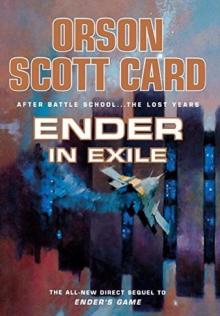 Ender in Exile
Ender in Exile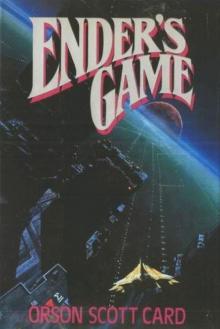 Ender's Game
Ender's Game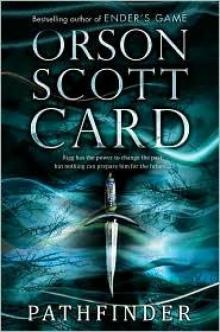 Pathfinder
Pathfinder Children of the Fleet
Children of the Fleet Children of the Mind
Children of the Mind Ruins
Ruins Speaker for the Dead
Speaker for the Dead Ender's Shadow
Ender's Shadow Folk of the Fringe
Folk of the Fringe Hart's Hope
Hart's Hope Shadow of the Giant
Shadow of the Giant Empire
Empire Shadow Puppets
Shadow Puppets Earth Afire
Earth Afire First Meetings in Ender's Universe
First Meetings in Ender's Universe Maps in a Mirror: The Short Fiction of Orson Scott Card
Maps in a Mirror: The Short Fiction of Orson Scott Card Xenocide
Xenocide The Swarm: The Second Formic War
The Swarm: The Second Formic War Saints
Saints Seventh Son: The Tales of Alvin Maker, Volume I
Seventh Son: The Tales of Alvin Maker, Volume I Zanna's Gift
Zanna's Gift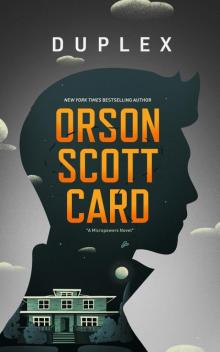 Duplex
Duplex Zanna's Gift- a Life in Christmases
Zanna's Gift- a Life in Christmases Hidden Empire
Hidden Empire Earth Awakens
Earth Awakens Visitors
Visitors Shadow of the Hegemon
Shadow of the Hegemon Alvin Jorneyman ttoam-4
Alvin Jorneyman ttoam-4 Federations
Federations The Gate Thief mm-2
The Gate Thief mm-2 First Meetings
First Meetings Capitol
Capitol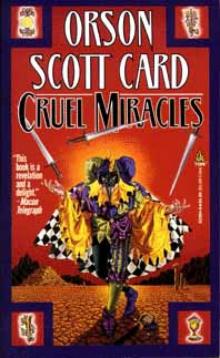 Cruel Miracles
Cruel Miracles Shadows in Flight, enhanced edition
Shadows in Flight, enhanced edition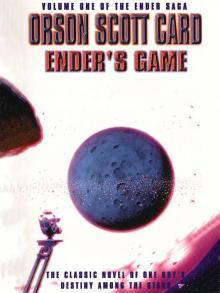 Ender's Game es-1
Ender's Game es-1 Ruins (Pathfinder Trilogy)
Ruins (Pathfinder Trilogy) Ender's Shadow ew-6
Ender's Shadow ew-6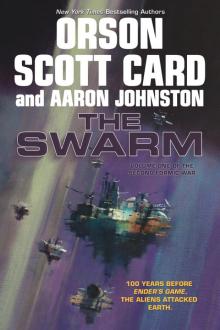 The Swarm
The Swarm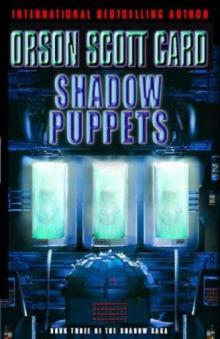 Card, Orson Scott - Ender's Saga 7 - Shadow Puppets
Card, Orson Scott - Ender's Saga 7 - Shadow Puppets Lost Boys: A Novel
Lost Boys: A Novel Mazer in Prison
Mazer in Prison Treason
Treason Heal Thyself
Heal Thyself The Call of Earth
The Call of Earth Songmaster
Songmaster Heartfire ttoam-5
Heartfire ttoam-5 Pastwatch
Pastwatch Gatefather
Gatefather The Ships of Earth: Homecoming: Volume 3
The Ships of Earth: Homecoming: Volume 3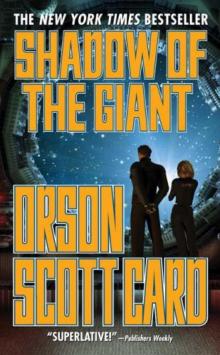 Orson Scott Card - Ender 08 - Shadow of the Giant
Orson Scott Card - Ender 08 - Shadow of the Giant Flux
Flux Speaker for the dead ew-2
Speaker for the dead ew-2 Grinning Man
Grinning Man Ruins sw-2
Ruins sw-2 Earth Unaware
Earth Unaware The Worthing Saga
The Worthing Saga Earthfall (Homecoming)
Earthfall (Homecoming) Card, Orson Scott - Ender's Saga 5 - Ender's Shadow
Card, Orson Scott - Ender's Saga 5 - Ender's Shadow The Abyss
The Abyss Magic Street
Magic Street Masterpieces
Masterpieces Prentice Alvin ttoam-3
Prentice Alvin ttoam-3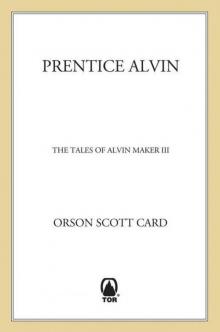 Prentice Alvin: The Tales of Alvin Maker, Volume III
Prentice Alvin: The Tales of Alvin Maker, Volume III Card, Orson Scott - Ender's Saga 3 - Xenocide
Card, Orson Scott - Ender's Saga 3 - Xenocide Homeless in Hell
Homeless in Hell Red Prophet: The Tales of Alvin Maker, Volume II
Red Prophet: The Tales of Alvin Maker, Volume II Earthborn (Homecoming)
Earthborn (Homecoming)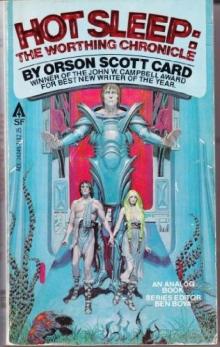 Hot Sleep
Hot Sleep The Hive
The Hive Rachel and Leah (Women of Genesis)
Rachel and Leah (Women of Genesis) Ender's World
Ender's World The Memory of Earth
The Memory of Earth Seventh Son ttoam-1
Seventh Son ttoam-1 Wyrms
Wyrms A Town Divided by Christmas
A Town Divided by Christmas Earth unavare (the first formic war)
Earth unavare (the first formic war) The Shadow of the Hegemon - Orson Scott Card
The Shadow of the Hegemon - Orson Scott Card Earthfall
Earthfall Lost Boys
Lost Boys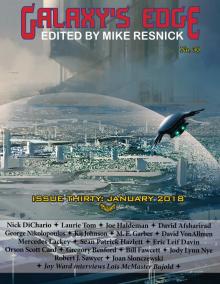 Galaxy's Edge Magazine
Galaxy's Edge Magazine Sarah: Women of Genesis: 1 (Women of Genesis (Forge))
Sarah: Women of Genesis: 1 (Women of Genesis (Forge)) The Crystal City: The Tales of Alvin Maker, Volume VI
The Crystal City: The Tales of Alvin Maker, Volume VI Xenocide ew-4
Xenocide ew-4 Earth Afire (The First Formic War)
Earth Afire (The First Formic War) Maps in a Mirror
Maps in a Mirror Pathfinder sw-1
Pathfinder sw-1 Red Prophet ttoam-2
Red Prophet ttoam-2 THE CRYSTAL CITY
THE CRYSTAL CITY 27 Short Stories
27 Short Stories Heartfire: The Tales of Alvin Maker, Volume V
Heartfire: The Tales of Alvin Maker, Volume V Alvin Journeyman: The Tales of Alvin Maker, Volume IV
Alvin Journeyman: The Tales of Alvin Maker, Volume IV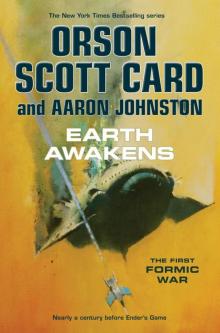 Earth Awakens (The First Formic War)
Earth Awakens (The First Formic War) THE SHIPS OF EARTH
THE SHIPS OF EARTH The Changed Man
The Changed Man Future on Fire
Future on Fire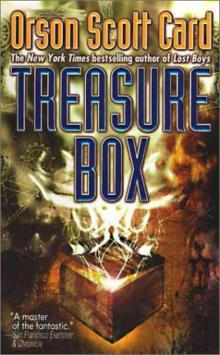 Treasure Box
Treasure Box The Gate Thief
The Gate Thief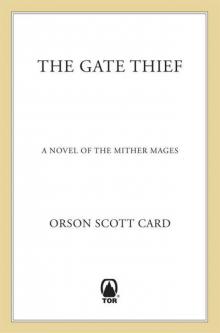 The Gate Thief (Mither Mages)
The Gate Thief (Mither Mages) First Meetings In the Enderverse
First Meetings In the Enderverse Earthborn
Earthborn Seventh Son
Seventh Son Pastwatch: The Redemption Of Christopher Columbus
Pastwatch: The Redemption Of Christopher Columbus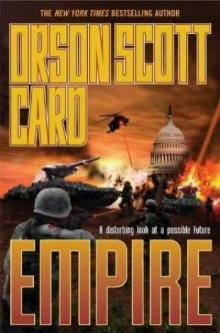 Empire e-1
Empire e-1 Keeper of Dreams
Keeper of Dreams Card, Orson Scott - Ender's Saga 1 - Ender's Game
Card, Orson Scott - Ender's Saga 1 - Ender's Game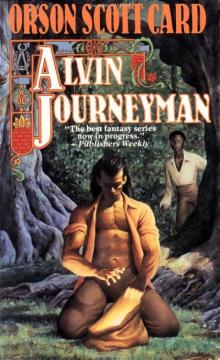 ALVIN JOURNEYMAN
ALVIN JOURNEYMAN The Lost Gate
The Lost Gate Feed The Baby Of Love
Feed The Baby Of Love Hot Sleep: The Worthing Chronicle
Hot Sleep: The Worthing Chronicle